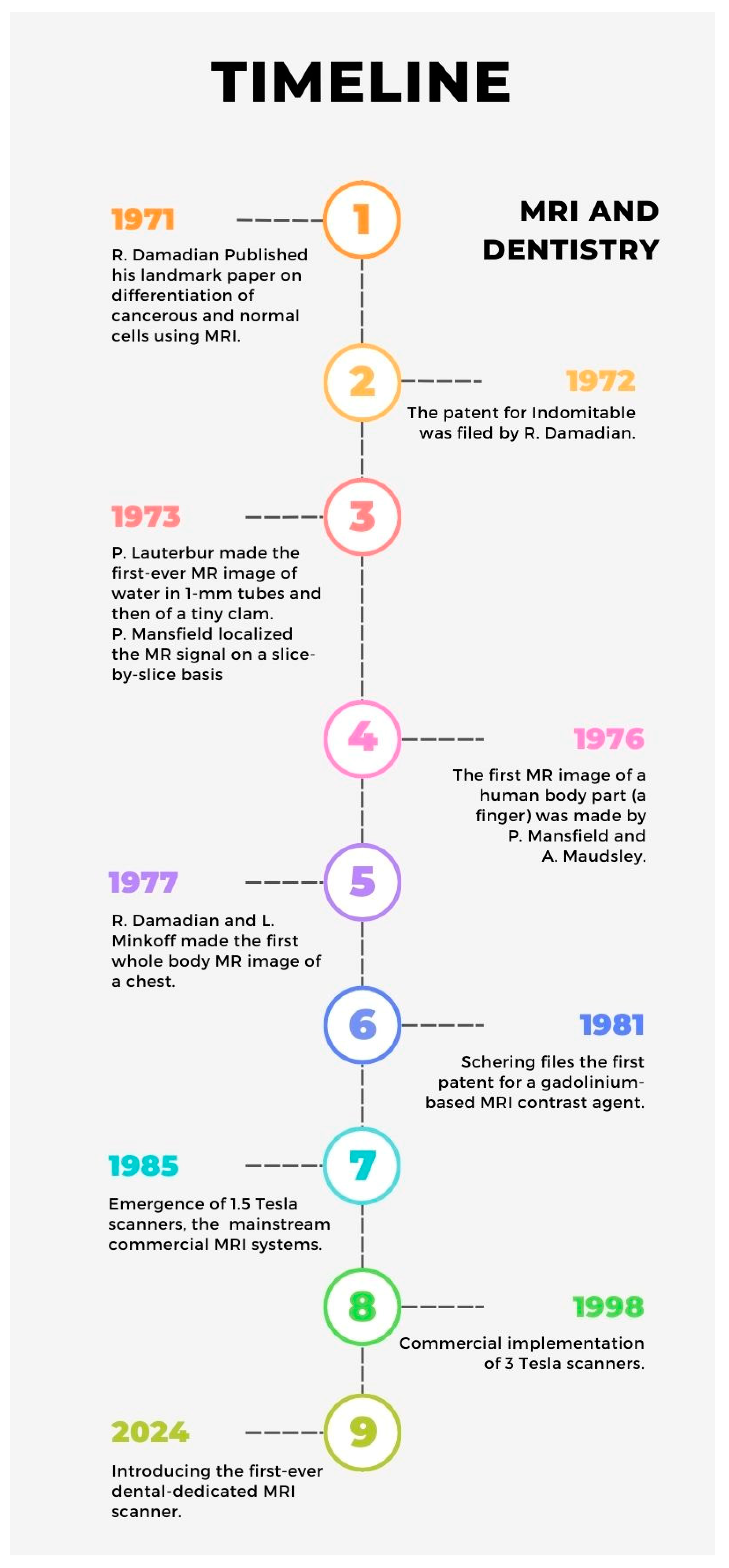Magnetic Resonance Imaging in Digital Dentistry: The Start of a New Era
Author Contributions
Funding
Conflicts of Interest
References
- Ueda, T.; Ohno, Y.; Yamamoto, K.; Murayama, K.; Ikedo, M.; Yui, M.; Hanamatsu, S.; Tanaka, Y.; Obama, Y.; Ikeda, H. Deep learning reconstruction of diffusion-weighted MRI improves image quality for prostatic imaging. Radiology 2022, 303, 373–381. [Google Scholar] [CrossRef] [PubMed]
- Yeung, A.W.K.; Leung, W.K. Functional neuroplasticity of adults with partial or complete denture rehabilitation with or without implants: Evidence from fMRI studies. Nutrients 2023, 15, 1577. [Google Scholar] [CrossRef] [PubMed]
- Lauterbur, P.C. Image formation by induced local interactions: Examples employing nuclear magnetic resonance. Nature 1973, 242, 190–191. [Google Scholar] [CrossRef]
- Edelman, R.R. The history of MR imaging as seen through the pages of radiology. Radiology 2014, 273, S181–S200. [Google Scholar] [CrossRef] [PubMed]
- Damadian, R. Tumor detection by nuclear magnetic resonance. Science 1971, 171, 1151–1153. [Google Scholar] [CrossRef] [PubMed]
- Speroni, S.; Bosco, F.; Ferrini, F.; Pittari, L.; Nota, A.; Tecco, S. The Use of a Surgical Template for the Insertion of Dental Implants and Sinus Lift with the Summers Technique Based on Digital Planning: A Case Report. Prosthesis 2024, 6, 206–215. [Google Scholar] [CrossRef]
- Reddy, N.; Vempalli, S.; Prakash, J.; Suganna, M.; Meenakshi, S.I.; Shivakumar, G.C.; Crimi, S.; Minervini, G. Evaluation of the Effect of Digital Dentistry on the Accuracy of Implant Placement and Prosthesis Fabrication—A Systematic Review and Meta-Analysis. Prosthesis 2023, 5, 666–677. [Google Scholar] [CrossRef]
- Sheikhi, M.; Karami, M.; Abbasi, S.; Moaddabi, A.; Soltani, P. Applicability of cone beam computed tomography gray values for estimation of primary stability of dental implants. Braz. Dent. Sci. 2021, 24, 8 P. [Google Scholar] [CrossRef]
- Reda, R.; Zanza, A.; Mazzoni, A.; Cicconetti, A.; Testarelli, L.; Di Nardo, D. An update of the possible applications of magnetic resonance imaging (MRI) in dentistry: A literature review. J. Imaging 2021, 7, 75. [Google Scholar] [CrossRef] [PubMed]
- Soltani, P.; Moaddabi, A.; Gilani, A.; Nafari, N.; Mirrashidi, F.; Devlin, H.; Spagnuolo, G. Temporomandibular disk position after orthognathic surgery: A systematic review. Semin. Orthod. 2024, 30, 355–366. [Google Scholar] [CrossRef]
- La Via, L.; Falsaperla, D.; Merola, F.; Messina, S.; Lanzafame, B.; Borzì, S.R.; Basile, A.; Sanfilippo, F. Comparison of the Airway Anatomy between Infants and Three Pediatric Simulators: A Radiological Study on Premature Anne, Infant AM Trainer and Simbaby Manikins. Prosthesis 2023, 5, 602–609. [Google Scholar] [CrossRef]
- Niraj, L.K.; Patthi, B.; Singla, A.; Gupta, R.; Ali, I.; Dhama, K.; Kumar, J.K.; Prasad, M. MRI in dentistry-A future towards radiation free imaging–systematic review. J. Clin. Diagn. Res. JCDR 2016, 10, ZE14. [Google Scholar] [CrossRef] [PubMed]
- Flügge, T.; Gross, C.; Ludwig, U.; Schmitz, J.; Nahles, S.; Heiland, M.; Nelson, K. Dental MRI—Only a future vision or standard of care? A literature review on current indications and applications of MRI in dentistry. Dentomaxillofacial Radiol. 2023, 52, 20220333. [Google Scholar] [CrossRef] [PubMed]
- Kocasarac, H.D.; Geha, H.; Gaalaas, L.R.; Nixdorf, D.R. MRI for dental applications. Dent. Clin. 2018, 62, 467–480. [Google Scholar]
- Charlotte, N.C. Dentsply Sirona and Siemens Healthineers Develop First Dental-Dedicated MRI System. Available online: https://www.dentsplysirona.com/en/company/news-and-press-release-detail-page.html/content/dam/master/news/en/corporate-news/2024/dentsply-sirona-and-siemens-healthineers-present-the-first-dental-dedicated-mri-system-to-the-scientific-community (accessed on 5 July 2024).
- Greiser, A.; Christensen, J.; Fuglsig, J.M.; Johannsen, K.M.; Nixdorf, D.R.; Burzan, K.; Lauer, L.; Krueger, G.; Hayes, C.; Kettless, K. Dental-dedicated MRI, a novel approach for dentomaxillofacial diagnostic imaging: Technical specifications and feasibility. Dentomaxillofacial Radiol. 2024, 53, 74–85. [Google Scholar] [CrossRef] [PubMed]
- Amin, S.A.; Hann, S.; Elsheikh, A.K.; Boltchi, F.; Zandinejad, A. A complete digital approach for facially generated full arch diagnostic wax up, guided surgery, and implant-supported interim prosthesis by integrating 3D facial scanning, intraoral scan and CBCT. J. Prosthodont. 2023, 32, 90–93. [Google Scholar] [CrossRef] [PubMed]
- Gibello, U.; Cemenasco, A.; Giordano, L.; Alovisi, M.; Cortese, L.; Balocco, A.; Berutti, E.; Pasqualini, D. Combined orthograde 3D navigation microsurgical endodontic retreatment for the management of persistent apical periodontitis in a mandibular molar. G. Ital. Endod. 2023, 37, 94–102. [Google Scholar]
- Wang, J.; An, Y.-X.; Shi, Y.-L.; Liu, L.-P.; Zhao, Y.-Q.; Wu, F.; Wei, H.-B. A digital workflow to predict facial aesthetics in patients with maxillofacial trauma with implant retained prostheses. J. Prosthodont. Res. 2023, 67, 481–486. [Google Scholar] [CrossRef] [PubMed]

Disclaimer/Publisher’s Note: The statements, opinions and data contained in all publications are solely those of the individual author(s) and contributor(s) and not of MDPI and/or the editor(s). MDPI and/or the editor(s) disclaim responsibility for any injury to people or property resulting from any ideas, methods, instructions or products referred to in the content. |
© 2024 by the authors. Licensee MDPI, Basel, Switzerland. This article is an open access article distributed under the terms and conditions of the Creative Commons Attribution (CC BY) license (https://creativecommons.org/licenses/by/4.0/).
Share and Cite
Spagnuolo, G.; Soltani, P. Magnetic Resonance Imaging in Digital Dentistry: The Start of a New Era. Prosthesis 2024, 6, 798-802. https://doi.org/10.3390/prosthesis6040056
Spagnuolo G, Soltani P. Magnetic Resonance Imaging in Digital Dentistry: The Start of a New Era. Prosthesis. 2024; 6(4):798-802. https://doi.org/10.3390/prosthesis6040056
Chicago/Turabian StyleSpagnuolo, Gianrico, and Parisa Soltani. 2024. "Magnetic Resonance Imaging in Digital Dentistry: The Start of a New Era" Prosthesis 6, no. 4: 798-802. https://doi.org/10.3390/prosthesis6040056





